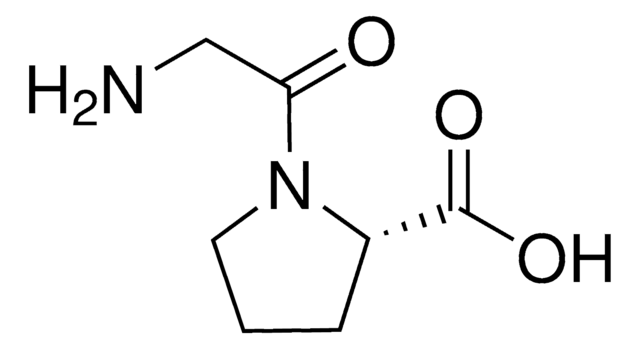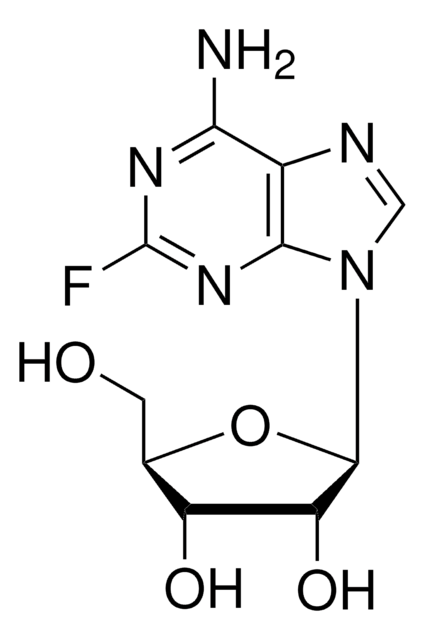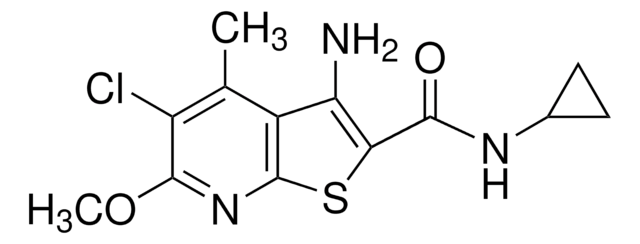SML0917
BMS-986122
≥98% (HPLC)
Sinónimos:
2-(3-Bromo-4-methoxyphenyl)-3-[(4-chlorophenyl)sulfonyl]-thiazolidine
Iniciar sesiónpara Ver la Fijación de precios por contrato y de la organización
About This Item
Fórmula empírica (notación de Hill):
C16H15BrClNO3S2
Número de CAS:
Peso molecular:
448.78
UNSPSC Code:
12352200
NACRES:
NA.77
Productos recomendados
assay
≥98% (HPLC)
form
powder
color
white to beige
solubility
DMSO: 20 mg/mL, clear
storage temp.
2-8°C
Biochem/physiol Actions
BMS-986122 is a positive allosteric modulator (PAM of the m-opioid receptor). BMS986122 displays little or no agonist activity alone, but dose dependently increases endomorphin-I induced b-arrestin recruitment, and inhibition of forskolin-induced adenyl cyclase activity. The compound also potentiates DAMGO-stimulated GTPgS receptor binding.
BMS-986122 is a positive allosteric modulator (PAM of the m-opioid receptor.
BMS-986122 may exhibit an antinociception effect in vivo by increasing the efficiency of Met-enkephalin (met-Enk) to inhibit γ aminobutyric acid (GABA) release in the periaqueductal gray region of the brain.
Features and Benefits
This compound is a featured product for Neuroscience research. Click here to discover more featured Neuroscience products. Learn more about bioactive small molecules for other areas of research at sigma.com/discover-bsm.
signalword
Warning
hcodes
Hazard Classifications
Eye Irrit. 2
Storage Class
11 - Combustible Solids
wgk_germany
WGK 3
flash_point_f
Not applicable
flash_point_c
Not applicable
Elija entre una de las versiones más recientes:
Certificados de análisis (COA)
Lot/Batch Number
¿No ve la versión correcta?
Si necesita una versión concreta, puede buscar un certificado específico por el número de lote.
¿Ya tiene este producto?
Encuentre la documentación para los productos que ha comprado recientemente en la Biblioteca de documentos.
Neil T Burford et al.
Proceedings of the National Academy of Sciences of the United States of America, 110(26), 10830-10835 (2013-06-12)
μ-Opioid receptors are among the most studied G protein-coupled receptors because of the therapeutic value of agonists, such as morphine, that are used to treat chronic pain. However, these drugs have significant side effects, such as respiratory suppression, constipation, allodynia
Ram Kandasamy et al.
Proceedings of the National Academy of Sciences of the United States of America, 118(16) (2021-04-14)
Positive allosteric modulators (PAMs) of the mu-opioid receptor (MOR) have been hypothesized as potentially safer analgesics than traditional opioid drugs. This is based on the idea that PAMs will promote the action of endogenous opioid peptides while preserving their temporal
Contenido relacionado
DISCOVER Bioactive Small Molecules for Neuroscience
Nuestro equipo de científicos tiene experiencia en todas las áreas de investigación: Ciencias de la vida, Ciencia de los materiales, Síntesis química, Cromatografía, Analítica y muchas otras.
Póngase en contacto con el Servicio técnico









